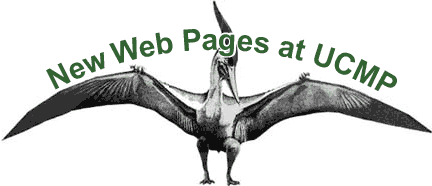
1999
Although the pace slowed a bit, we made some nice additions to our extensive exhibits during 1999. We have even more in store for 2000.
November 1999- November 29: The tuatara is the only living species of sphenodontid, though there were many unusual members of this group millions of years ago.
- October 17: Though the hollies have been around for almost 100 million years, they're new on our server.
- October 11: A mean new set of pages on sea scorpions replaces a very old exhibit on our server.
- Oct 6: We are one of the sites chosen to be included in CyberSurfari's fall treasure hunt! Check out their web site for more details and then take part in this fun and cool activity.
- September 30: Kimberella, a very cool fossil from the Vendian period, has been added to our exhibit on the earliest known animals.
- September 26: We've added new pictures and information to our page on monocot morphology, with pictures of monocot stem structure and embryo morphology.
- September 25: Our listings of natural history booksellers has been updated.
- September 24: We've put up a basic page on water lilies, with more information on the way!
- September 23: What on earth is a homalozoan?
- September 22: The very odd, very early echinoderms, Helicoplacoidea, can now be found on our server.
- September 21: Small but necessary improvements have been made to the Web Lift to Taxa to accomodate the growth of some exhibits.
- September 20: A late blooming exhibit on asterids brings promise of pages on many important flowering plant groups. Watch as this exhibit grows!
- September 19: We've been making some additions to our pages on the Vendian. We've added a stratigraphy page, and made additions to the exhibits on the Ediacara Hills and the fossils found there.
- September 18: The Ediacaran fossil Arkarua may be the oldest fossil of an echinoderm. Read the evidence, then decide for yourself!
- September 15: The echinoderm systematics page has a new cladogram, revised based on new findings presented at the symposium in San Francisco last year.
- September 7: We've added new text and images to our page on the Xiphosurans (horseshoe crabs).
- September 3: An extinct group of plants known as the Cladoxylopsida are probably close relatives of the earliest ferns and horsetails. You may not be able to pronounce Cladoxylopsida, but you can still read about them on our server!
- September 1: The frameless version of our popular Web Lift has been given a long overdue update. In addition, major taxa now appear in boldface type for easier browsing.
- August 31: We've added more text to our Eocene exhibit, and created a page on the climate and tectonics of that epoch.
- August 30: A richly illustrated exhibit on the Green River Formation includes plants, insects, and vertebrates from our UCMP collections.
- August 29: We've slightly expanded our exhibit on the Eocene by adding a listing of Fossil Localities.
- August 28: The Navigational Guide to our exhibits has been updated.
- July 19: Join UCMP in Colorado for the Geologic Society of America's annual meeting. We'll be presenting a workshop on teaching evolution in the classroom.
- June 19: Join us at the seashore for another look at our Education and Public Outreach section of the web site. Also, if you ever wondered about evolution of animals, how molluscs feed or about populational variability in genes and feeding morphology, take a look at some supplementary information from papers published or soon-to-be-published by museum researchers. It's fascinating stuff, so check it out.
- June 18: Ryosuke Motani, a post-doc here with Dr. Kevin Padian has put together some really cool information on ichthyosaurs.
- June 18: An overview of a research project by one of UCMP's recent graduates, Chris Meyer, has been put on-line. The Cowrie Genetic Database Project aims to determine the phylogenetic relationships of these beautiful gastropods, and to use that phylogeny to answer questions relating to biogeography and speciation processes.
- April 28: You've read about it in the newspapers and heard about it on the evening news, now you can learn all about the Sulawesi coelacanths from the UC Berkeley researchers who made the discovery.
- March 2: We've added a timeline of key figures in the development of evolutionary thought
- February 11: Our long-awaited exhibit on the Rhynie Chert of Scotland is now available. Learn about this early terrestrial ecosystem, including early fossil plants, bugs, and fungi.
- January 24: Our pages on the so-called Moss Animals, or Bryozoa have been given a little facelift.
- January 18: We've revised our exhibit on the lilies, and have added a picture of a fossil species.
- January 10: More Geology Wing additions: Silurian tectonics and paleoclimate.
- January 7: We've added much to our page on Permian stratigraphy.
- January 3: New pictures have been added to our pages on the fossil record of kelps and the ecology of chromists.
- January 2: More additions to our Silurian exhibit, including a new page on life in the Silurian.
This year | 2005 | 2004 | 2003 | 2002 | 2001 | 2000 | 1999 | 1998 | 1997 | 1996 | 1995 | 1994